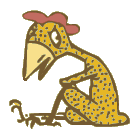


 "What To Show Your Friends When You Think They're Ready To Read Comics" (by Mary Burt) "What To Show Your Friends When You Think They're Ready To Read Comics" (by Mary Burt)So your friends seem eager to learn more about your mysterious world of comic book fandom. You, of course, are eager to share, but you don't want to overwhelm them or frighten them away from an experience you find so infinitely rewarding. In other words, as much as you love The Acme Novelty Library, reading all eight issues at once can be a little bewildering. Remember, you've had a few months between each issue to get over the overpowering combination of comedy and tragedy in each issue and to come to terms with the fact that Chris Ware hasn't read your diary and written to directly mock you. The budding comic fan hasn't. With this in mind, here are some suggestions for introducing your friends to the wonderful world of comics. Of course, the two most popular comic books, and the most accessible to the uninitiated, are Peter Bagge's Hate and Dan Clowe's Eightball. If your friends drink a lot, watch a lot of television, and enjoy references to popular music from the 50s to the 90s, Hate is the obvious choice. It's sitcom-ish humor combined with its rubbery character illustrations make it immediately appealing to those who don't want to waste their time waiting for a plot to define itself. Hate is action-packed and hilarious and once your friends are hooked, you can show them your old copies of Neat Stuff and the Peter Bagge collections from Fantagraphics including Junior and Other Losers and The Bradleys. For your more high-brow friends to whom you have to prove that comics aren't just for kids or for adults who never grew up. Eightball is a more appropriate choice. It's artwork and writing are conventional enough to be understandable and enjoyable to those with traditional ideas of how such things should be. However, Dan Clowes takes these conventions to new levels by challenging the reader. His stories always leave once feeling slightly uncomfortable, but the artwork and writing are so undeniably good that you have to read each issue again and again to get over the unsettling feeling of the first reading. High-brow people love this sort of thing. They love things that border on the confrontational and controversial, because it gives them something to ponder. Another good idea is to start your friends off with a collection of different artists. In book form, the two best are Blab! (Kitchen Sink Press) and Raw (Penguin Books). Blab! Tends to have a more diverse selection than Raw. It also seems to come out more regularly. Again, the distinction you need to make about your friends is whether they would be interested in comics as entertainment, or as an art form. (The two aren't mutually exclusive, but most people have a preference.) While Blab! would appeal to both, Raw predominantly appeals to those who see the comics medium as an art form. In comic book form, the two that come immediately to mind are Drawn & Quarterly (Drawn & Quarterly) and Zero Zero (Fantagraphics). Both come out regularly and both have a really good selection of established cartoonist and newcomers. You could also try the historical significance route by showing your friends the work of people like Winsor McKay, George Herriman, Ernie Bushmiller, or even Charles Schulz. After you've established how great they are, show your friends how their work has influenced that of your favorite cartoonists, including Chris Ware, Peter Bagge, Kim Deitch, and Joe Matt. Or you could take your friends to see Crumb and let them borrow your copy of Carload O'Comics or Weirdo or Zap or whatever you can bear to part with after watching that film and rediscovering his genius a tenth time. Or you could invite your friends over and make them wait in a living room filled with nothing but comics while you take a half an hour to get ready. That's enough time to read enough of a comic book to want to read more. And then you're well on your way to have someone to go into that big scary comic book shop with you. Of Course, there are other avenues or artist you can use to introduce your friends. (One person I know has been particularly successful with Joe Matt cartoons.) But you must go with your instinct and follow a few basic rules. 1. Don't give them every issue of any artist. It's too much and it scares them. 2. You have to hype what you're giving them and tell them exactly what to appreciate about the comic. It's not that they are too ignorant to figure out what they like, but it helps to know what to look for in a comic book. 3. Don't assume that they could never possibly understand the beauty of comics. That alienates them and makes them afraid to be curious. Other than that, your're on your own. Good luck! |
ESSENTIAL SEQUENTIALS!
Oh yeah, look at this new...
Exceptional Seque...no...
Exquen...aarghh! It's down there!
• Boody Rogers
• Little Lulu
• Popeye
• Tin Tin
• EC Comics
• Mad Magazine
• The Spirit
• Uncle Scrooge
• Peanuts
• Zap
• New Gods
• I Saw It
• Corporate Crime